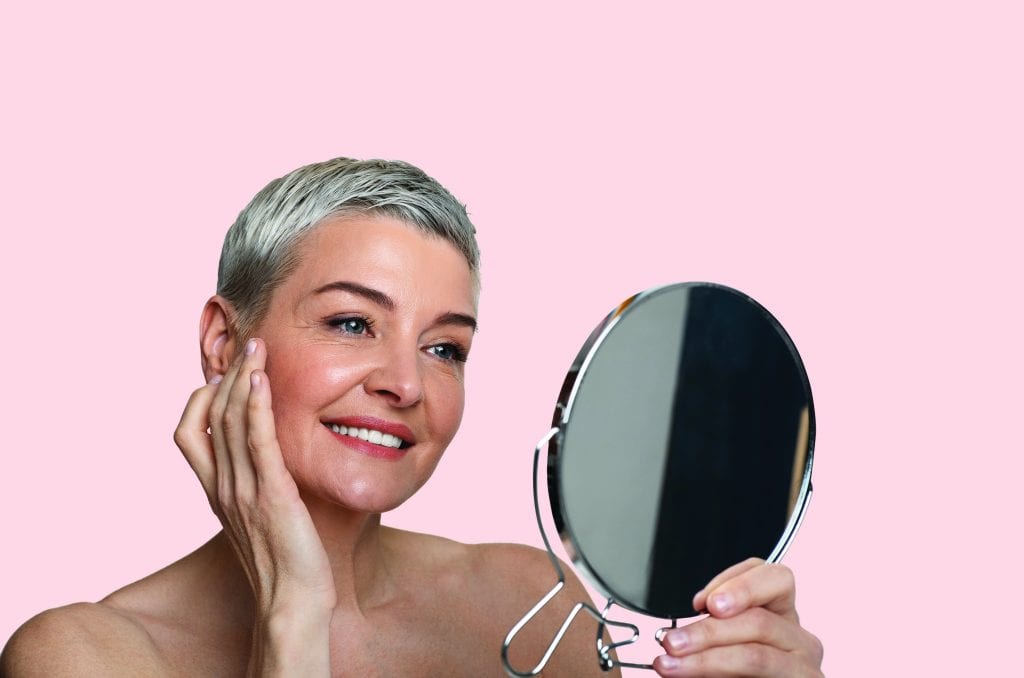We always want to put our best face forward, and thanks to skilled and knowledgeable practitioners, there are countless cosmetic procedures that can help us do just that. Whether you are looking for something noninvasive with fast results or are willing to consider surgery for a long-lasting solution, there is an option to fit your needs. We reached out to local experts for different solutions to two common problems.
bright eyes
Ptosis is a condition in which the upper eyelid droops or lays lower than normal. It can be the result of age, trauma or other medical conditions, and the drooping can be slight or severe enough to limit your field of vision. “If you have a low hanging lid, it may affect the way you see things, and cosmetically, it can make you appear tired,” says Jackie Carr, R.N., ANP-BC, LE, owner of Pur-One Medispa. She says a new prescription eye drop called Upneeq can offer a noninvasive solution for those dealing with mild to moderate cases.
The eye drop works by stimulating Muller’s muscle, which is responsible for maintaining elevation of the upper eyelid. In clinical trials, 84% of patients saw some benefit, and 74% had a more than 50% improvement. Carr says the drops can take effect in as little as 15 minutes, and the results can last up to 13 hours. “You don’t have to use them every day, so it’s very flexible,” she notes. “Right now, if you’re working from home, you may not need to use them regularly, but you can if you have a Zoom call and want to look nice.”
Upneeq can be used with contacts and other eye drops. Carr suggests people who are prone to dry eyes or have Sjögren’s syndrome pair the treatment with lubricating drops. “If dryness worsens or becomes bothersome, consult your opthamologist, and consider discontinuing use of the product,” she says. “It shouldn’t be used by patients with angle-closure glaucoma because it potentially will increase intraocular pressure.”
The eyedrops don’t treat ptosis that is not caused by Muller’s muscle, but Carr says they are a good option for many people, especially those who may be hesitant to consider surgery. “It’s great for patients who are curious about seeing how they can improve their vision and appearance,” she notes. “It is cost effective and doesn’t come with the risk or downtime of something more invasive. Of course, if you like what the drops do for you, surgery could be an option further down the line.”
For a more permanent solution to droopy eyes, SLUCare plastic surgeon Dr. Sumesh Kaswan says different surgical options can address different root causes. “People often complain of heavy eyelids and excess skin interfering with their vision,” he notes. “We can address that with blepharoplasty, an outpatient procedure that removes excess skin, muscle and fat on the upper and lower eyelids. We also can do ptosis repair, which tightens or shortens the eyelid muscle to eliminate the droop.” Depending on what is determined during initial consultations, the procedures can be paired together to maximize results or with a brow lift if a drooping brow also is a concern.
After blepharoplasty, Kaswan says patients generally can return to normal activity in seven to 10 days. “While it is a surgical procedure, there is relatively little downtime,” he notes. “The biggest downside is probably the initial swelling. You should notice a significant change in about two weeks, and final results are visible in about a month. The biggest upside is that the results are long lasting.”
chin up
A double chin is a problem for many. Even with proper diet and exercise, that stubborn, little pocket of fat can be difficult to get rid of. Kaswan says liposuction was a common solution in the past, but now, he often uses CoolSculpting to address the problem, which offers a less invasive experience for patients. The treatment hypercools an area of localized fat. Since other bodily tissue isn’t as sensitive to cold as fat cells, fat cells are the only ones damaged in the process.
CoolSculpting is an in-office procedure, and there is little to no downtime or restrictions following a treatment. After a session, Kaswan has patients return to the office for a follow-up visit in four to six weeks. “That’s when final results will be visible,” he notes. “During that visit, we assess everything and determine if the patient would benefit from more sessions. Some people are satisfied after one, but others require additional treatment to get the desired results.”
Kaswan notes CoolSculpting is not a good option for people who have skin damage or excess wrinkles. “After treating the area, the fat breaks down and the skin retracts, so skin quality is an important factor,” he explains. “Individuals with significant aging or jowling would benefit from a face- or neck-lift.” Both procedures involve tightening underlying tissue and removing excess facial skin and fat. Unlike CoolSculpting, they also help address some of the cosmetic concerns of aging, like sagging skin and loss of facial volume.
Both a face- and neck-lift require anesthesia, but patients do not have to stay overnight in the hospital. Since these are more invasive treatments, Kaswan notes that there are activity restrictions for the first two weeks. Additionally, patients can expect swelling to last for three to four weeks. “In terms of seeing full results, it may take six to eight weeks,” he adds.
Regardless of whether you are looking for a noninvasive or invasive option, Kaswan says it is important to carefully discuss your concerns and desires with your practitioner. “A large part of what we do is personalized and customized based on what patients need and want,” he explains. “Through consultation and examination, we can determine what procedure will best benefit you.”
